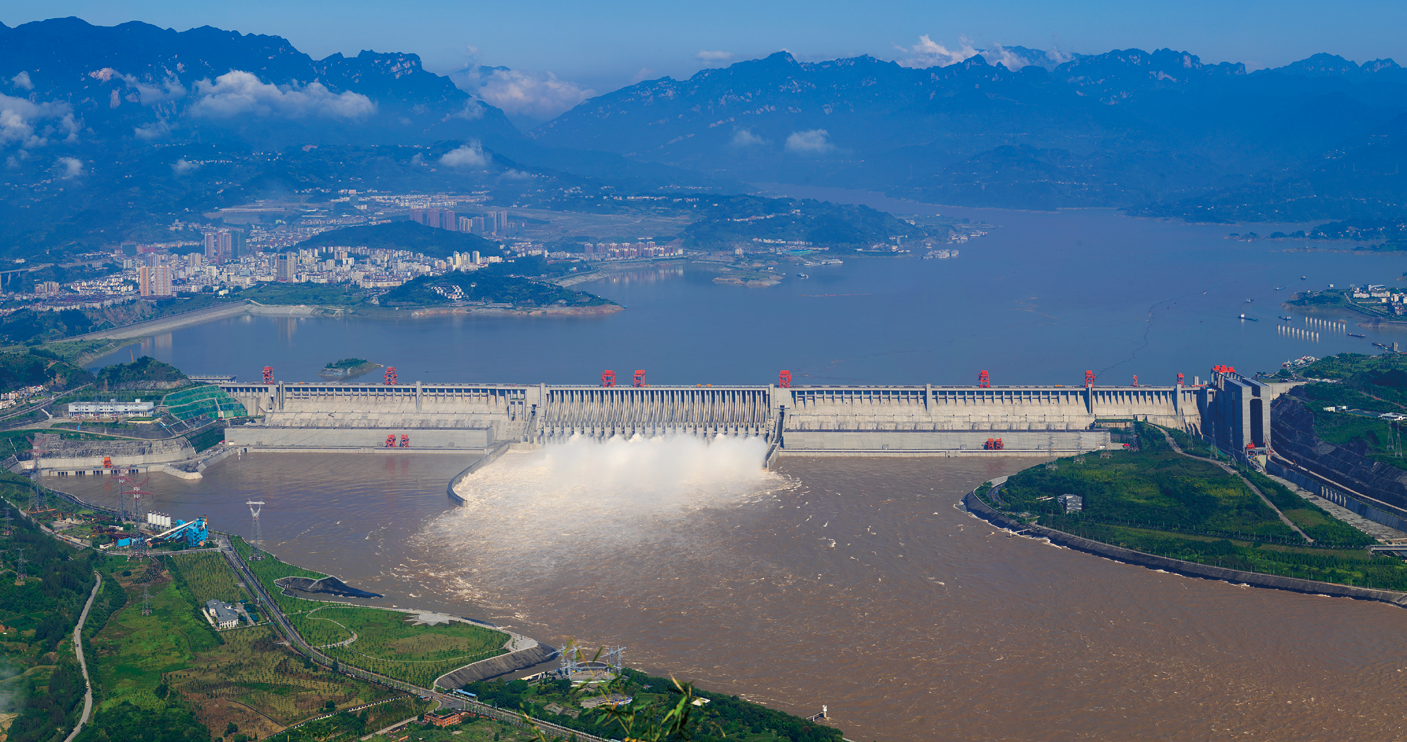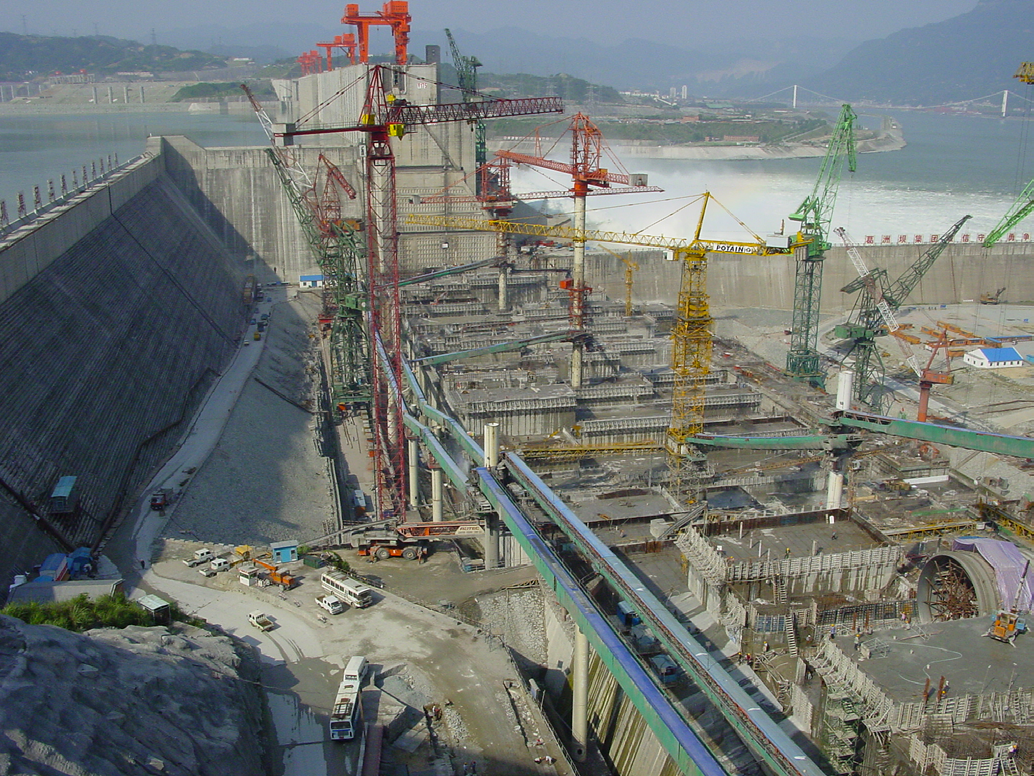《1. Overview》
1. Overview
The Three Gorges Project is the largest hydro junction project in the world. A key backbone project for the harnessing and exploitation of the Yangtze River, the Three Gorges Project consists of the pivotal dam project, a power transmission and transformation project, and a resettlement project (see Figure 1).
《Fig. 1》

Fig.1 The completed Three Gorges Hydro Junction Project (2014, Zhengping Huang).
The axis of the Three Gorges Dam is a total of 2309 m long, the dam crest level is 185 m, and the normal pool level is 175 m. Navigation structures include a permanent navigation lock and a ship lift. The permanent navigation lock is a double-line, five-level, multistage flight lock with a designed annual unidirectional tonnage capacity of 50 million tons. The ship lift is a single-line, one-level, steep-lifting type with a lifting height of 113 m, and a gross ship box weight of about 15 500 t—the largest lifting height and weight in the world.
The power transmission and transformation project involved the construction of 6519 km of 500 kV AC transmission line with a transformation capacity of 22 750 MVA and 2965 km of±500 kV DC transmission line with a DC converter station capacity of 18 000 MW.
After 40 years of planning, surveying, researching, designing, and testing from the early 1950s onwards, the 5th session of the 7th NPC finally approved the Resolution on the Construction of the Yangtze River in April 1992. Construction officially commenced in December 1994, and the diversion closure of the river was carried out in November 1997. In May 2006, the entire dam reached a height of 185 m. In December 2009, the project completed the scheduled preliminary design tasks. In December 2010, the target of trial water storage to 175 m was successfully completed. In 2011, the International Commission on Large Dams presented the “International Milestone Concrete Dam Project Award” to the Three Gorges Project. In 2013, the International Federation of Consulting Engineers granted the “FIDIC Centenary Award” to the Three Gorges Project.
《2. Major technical challenges and solutions》
2. Major technical challenges and solutions
The Three Gorges Dam is designed to withstand a 1000-year flood, and to survive a 10 000-year flood plus 10%; the corresponding flood discharges are 98 800 m³·s−1 and 124 300 m³·s−1, respectively. Flood discharge from the dam features a high water head, a large volume of overflow discharge, and a large quantity of sediment outflow. To address both the removal of floating debris in the reservoir, and the diversion required by the construction, a three-layer large outlet layout was adopted after considerable debate, and after modeling with multiple programs. This three-layer outlet required a deep discharge outlet, a surface discharge outlet, and a bottom fluid-diversion outlet in the flood-discharge dam section. It overcame the challenge of dealing with a large volume of flood discharge, and also saved on the engineering work already invested in the project.
The concrete in the Three Gorges Dam occupies as much as 28 million m³, twice as much as the concrete in the Itaipu Hydroelectric Power Station, and with a shorter construction period. Rapid concrete construction is key to a scheduled performance. The adoption of a tower belt crane led to the new technique of continuous concreting from mixer plant to placement section, realizing the high-intensity feeding of concrete. In the year 2000, the project created a world record of an annual 5.48 million m³ of concrete placement, with 553 500 m³ per month, and 22 000 m³ per day (Figure 2).
《Fig. 2》

Fig.2 Construction site of the Phase III Dam.
The greatest water depth of the diversion closure was 60 m, and the closure discharge volume was about 8480–11 900 m³·s−1, with both depth and volume ranking as world records. Pre-flow diversion by a constructed open-diversion channel and a pre-dumped bottom cushion reduced the difficulty of the closure, and created a world closure-construction record of 194 000 m³·d−1 of continuous landfill.
The turbogenerator unit of the project has one of the largest unit capacities in the world; the maximum water-head variation is 52 m, ranking top among units with similar capacity. The project also developed and adopted a generating unit with “fully air-cooling” and “evaporative-cooling” technologies, providing better operation reliability than “water-cooling” technology.
The ship lock of the Three Gorges Project has a designed total water head of 113 m; its delivery head is 45.2 m, and the peak height of the structure is 70 m, making it the highest liner-type ship lock in the world. A high-performance drainage system and a draw-cut type of high-strength bolt structure were adopted to form the world’s first “fully liner-type” ship lock; this new lock is a significant and innovative development from the traditional gravity-type lock.
The Three Gorges Project uses a patented double air-cooling technology to realize the stable maintenance of low-temperature concrete at 7 °C at the outlet. The project adopts an individualized dynamic water-cooling technique, and uses a new type of surface insulation material to control the mass concrete temperature and to prevent cracking. More than 4 million m3 of concrete has been placed for the Phase III dam and, through site inspection, no temperature cracking has been found—a miracle in the history of concrete gravity dams.
《3. Major project benefits》
3. Major project benefits
After 20 years of hard work, the construction task of the Three Gorges Project is basically complete; the dam is now beginning to produce huge and comprehensive benefits such as flood control, power generation, waterway transport, and water-resource utilization.
《3.1. Flood control》
3.1. Flood control
The Three Gorges Reservoir has a water area of 1084 km2 and a storage capacity of 39.3 billion m3, with a flood-storage capacity of 22.1 billion m3. On its completion, the Three Gorges Project will improve the flood-control criteria for the Jingjiang river reach from once in a decade to once in a century. During the flood seasons in 2010 and 2012, the Three Gorges Project underwent inflow peak floods of 70 000 m3·s−1 and 71 200 m3·s−1, respectively, which effectively mitigated the flood-control pressure along the middle and lower reaches of the Yangtze River and protected the lives and property of over 15 million people and 23 million mu of land.
《3.2. Power generation》
3.2. Power generation
The Three Gorges power station has 34 power sets (32 units with a unit capacity of 700 000 kW and 2 units with a unit capacity of 50 000 kW) with an installed gross capacity of 22.5 million kW. Its annual power generation is 100 billion kWh, which is equivalent to a yearly reduction of 50 million tons of raw coal consumption and a yearly reduction of 100 million tons in carbon dioxide emissions. In 2014, the Three Gorges power station generated a total of 98.8 billion kWh of electricity, exceeding the world record for annual power generation from a single hydroelectric power station, a record that had previously been created by the Itaipu Binacional. With a total electricity generation exceeding 800 billion kWh by the end of 2014, the Three Gorges power station has effectively relieved the shortage of electricity in East China, Central China, and Guangdong, and has become a valuable large production base of clean energy in China.
《3.3. Navigation》
3.3. Navigation
The Three Gorges Project improves the navigation conditions from Yichang to Chongqing, a distance of about 660 km, and along the middle and lower reaches of the Yangtze River in the low-flow season. As a result, a 10 000 tonner fleet can travel all the way from Hankou to Chongqing, reducing transportation costs significantly. In 2011, the freight volume through the Three Gorges navigation lock reached 100.3 million tons, achieving its planned target 19 years in advance. Over the lock’s 10 years of navigation, the accumulated freight in transit has reached 700 million tons. Thus, the Yangtze River has become an extremely profitable watercourse.
《3.4. Comprehensive water resource utilization》
3.4. Comprehensive water resource utilization
The abundant fresh water stored in the Three Gorges Reservoir is a valuable strategic fresh-water resource in China, and could provide a guaranteed water source for water-deficient areas in northern China. The Three Gorges Reservoir could supplement the middle and lower reaches of the Yangtze River with more than 20 billion m3 in the low-flow season every year, adding an average depth of about 0.8 m to the main channel. This supplementary water could effectively mitigate shortages in water for production, living, and ecological needs along the middle and lower reaches of the Yangtze River.
In spite of the stunning benefits brought by the Three Gorges Project, it will also cause certain impacts on peripheral areas and the downstream eco-environment. In particular, the reservoir shore reconstruction might give rise to geological hazards and have impacts on the water quality and aquatic life in the reservoir, as well as in the downstream rivers and lakes. Therefore, we must pay close attention to these matters.
《4. Future work》
4. Future work
To fit in with the new strategic positioning of the Three Gorges Project and the reservoir region in coming years, the Chinese government has made a significant deployment of resources toward subsequent work in the Three Gorges region. With the wellbeing and enrichment of millions of migrants as the intent and purpose of subsequent work, we should accelerate the development of a generally affluent society in the reservoir region. We should give priority to the re-establishment and protection of the ecological environment; ensure the effective protection of this national strategic fresh-water resource pool; and strengthen our observation and treatment of impounding influences, making use of advantages while striving to avoid disadvantages. We should also enhance our integrated management, optimize our regulation, and improve our ability in and level of scientific management for the Three Gorges Project. In this way, we can ensure the long and safe running of the dam and sustain its comprehensive benefits; drive economic and social development in the Three Gorges region, enabling the development of a harmonious society; improve the ability of the Three Gorges Project to serve the national economy and nation-wide social development; and thus provide improved benefits to the people.













 京公网安备 11010502051620号
京公网安备 11010502051620号




